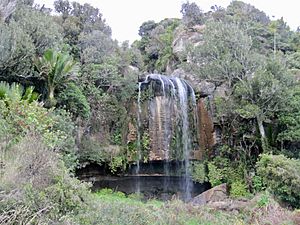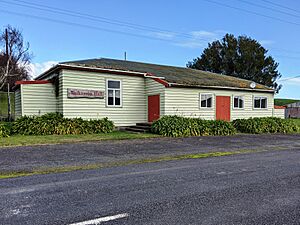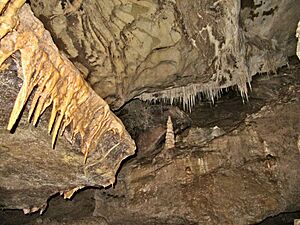Waikaretu facts for kids
Quick facts for kids
Waikaretu
Waikāretu
|
|
|---|---|
|
Hamlet
|
|

Waikapakapa Stream waterfall, Waikaretu
|
|
| Country | New Zealand |
| Region | Waikato |
| District | Waikato District |
| Ward | Onewhero-Te Akau Ward |
| Community | Onewhero-Tuakau Community |
| Electorates |
|
| Area | |
| • Total | 133.47 km2 (51.53 sq mi) |
| Population
(2018)
|
|
| • Total | 141 |
| • Density | 1.056/km2 (2.736/sq mi) |
Waikaretu (which is also spelled Waikāretu in Māori) is a small rural area in the Waikato District of New Zealand's North Island. It's about 49 kilometres southwest of a town called Tuakau.
The name Waikāretu comes from the Māori language. Wai means water, and kāretu is a type of sweet-smelling grass. So, the name means "waters of the kāretu grass."
If you visit, you can find a local farmstay. This is a place where you can stay on a farm. They also offer fun guided horse treks.
Contents
Exploring Waikaretu's Past
Early Days in Waikaretu
The main settlement of Waikaretu began in 1924. This was when the local school first opened its doors.
Later, in 1952, the Waikaretu War Memorial Hall was built. This hall remembers people who served in World War I and World War II. It has a special plaque to honor them.
Waikaretu in the 2000s
By the 2010s, Waikaretu had many dairy farms. These farms produce milk. One of them was the Whitford farm, which had been run by the same family for three generations.
In 2016, a company from China bought a large piece of coastal land. They planned to use some of it for a lodge and a training center. The rest of the land would continue to be a sheep and beef farm. This company also helped the local Waikaretu School with money.
Around the same time, a group started digging near a road. They were looking for old skeletons. They stopped digging in 2020 after people raised concerns.
Discovering Nikau Cave
One of the most exciting places in Waikaretu is the Nikau Cave. This cave is about 1 kilometre long. Inside, you can see amazing natural formations. These include limestone pillars, stalactites, and stalagmites. Stalactites hang down from the cave ceiling, and stalagmites grow up from the floor.
The cave is also home to thousands of tiny glow-worms. You can see them up close, lighting up the darkness. Guided tours are available, which last about 90 minutes. Be ready for a bit of a wet and muddy adventure!
There's a cafe for visitors and places to stay nearby. In 2020, a study found that Nikau Cave was one of New Zealand's best secret tourist spots.
How Nikau Cave Opened to Visitors
Philip and Anne Woodward moved to the area in 1978. They bought a farm that included Nikau Cave. They used to farm sheep and dairy cows.
In 1994, they decided to open the cave to the public. This happened after their farming lease ended. They needed a new way to make money.
The cave itself formed in Waimai Limestone. This rock is very old, about 28 million years old! It's mostly made of calcium carbonate. Near the cave, there's also a path. It goes beside the Waikaretu Stream. This path leads through protected bush areas to a beautiful waterfall.
People and Community in Waikaretu
Waikaretu is a small community. In 2018, 141 people lived there. This was a small increase from earlier years. There were 51 households in the area.
The people in Waikaretu come from different backgrounds. About 57% are European, and nearly 49% are Māori. Some people also identify as Pacific peoples or Asian.
When it comes to beliefs, most people in Waikaretu said they had no religion. About 25% were Christian. A small number followed Māori religious beliefs or other religions.
Many adults in Waikaretu are employed full-time. Some work part-time. The average income for people over 15 was $32,600.
Learning in Waikaretu
Waikaretu School is the local primary school. It teaches students from Year 1 to Year 8. It is a co-educational school, meaning both boys and girls attend. As of 2023, the school has 20 students.



